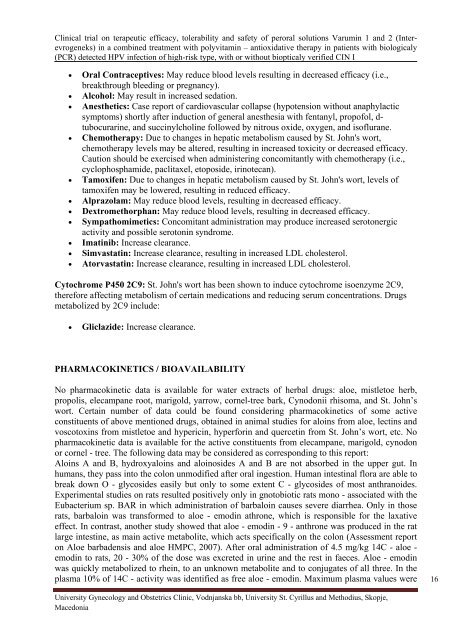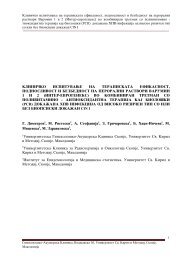klini^ko ispituvawe na terapiskata efikasnost, podnoslivost i
klini^ko ispituvawe na terapiskata efikasnost, podnoslivost i
klini^ko ispituvawe na terapiskata efikasnost, podnoslivost i
You also want an ePaper? Increase the reach of your titles
YUMPU automatically turns print PDFs into web optimized ePapers that Google loves.
Clinical trial on terapeutic efficacy, tolerability and safety of peroral solutions Varumin 1 and 2 (Interevrogeneks)<br />
in a combined treatment with polyvitamin – antioxidative therapy in patients with biologicaly<br />
(PCR) detected HPV infection of high-risk type, with or without biopticaly verified CIN I<br />
• Oral Contraceptives: May reduce blood levels resulting in decreased efficacy (i.e.,<br />
breakthrough bleeding or preg<strong>na</strong>ncy).<br />
• Alcohol: May result in increased sedation.<br />
• Anesthetics: Case report of cardiovascular collapse (hypotension without a<strong>na</strong>phylactic<br />
symptoms) shortly after induction of general anesthesia with fentanyl, propofol, dtubocurarine,<br />
and succinylcholine followed by nitrous oxide, oxygen, and isoflurane.<br />
• Chemotherapy: Due to changes in hepatic metabolism caused by St. John's wort,<br />
chemotherapy levels may be altered, resulting in increased toxicity or decreased efficacy.<br />
Caution should be exercised when administering concomitantly with chemotherapy (i.e.,<br />
cyclophosphamide, paclitaxel, etoposide, irinotecan).<br />
• Tamoxifen: Due to changes in hepatic metabolism caused by St. John's wort, levels of<br />
tamoxifen may be lowered, resulting in reduced efficacy.<br />
• Alprazolam: May reduce blood levels, resulting in decreased efficacy.<br />
• Dextromethorphan: May reduce blood levels, resulting in decreased efficacy.<br />
• Sympathomimetics: Concomitant administration may produce increased serotonergic<br />
activity and possible serotonin syndrome.<br />
• Imatinib: Increase clearance.<br />
• Simvastatin: Increase clearance, resulting in increased LDL cholesterol.<br />
• Atorvastatin: Increase clearance, resulting in increased LDL cholesterol.<br />
Cytochrome P450 2C9: St. John's wort has been shown to induce cytochrome isoenzyme 2C9,<br />
therefore affecting metabolism of certain medications and reducing serum concentrations. Drugs<br />
metabolized by 2C9 include:<br />
• Gliclazide: Increase clearance.<br />
PHARMACOKINETICS / BIOAVAILABILITY<br />
No pharmacokinetic data is available for water extracts of herbal drugs: aloe, mistletoe herb,<br />
propolis, elecampane root, marigold, yarrow, cornel-tree bark, Cynodonii rhisoma, and St. John’s<br />
wort. Certain number of data could be found considering pharmacokinetics of some active<br />
constituents of above mentioned drugs, obtained in animal studies for aloins from aloe, lectins and<br />
voscotoxins from mistletoe and hypericin, hyperforin and quercetin from St. John’s wort, etc. No<br />
pharmacokinetic data is available for the active constituents from elecampane, marigold, cynodon<br />
or cornel - tree. The following data may be considered as corresponding to this report:<br />
Aloins A and B, hydroxyaloins and aloinosides A and B are not absorbed in the upper gut. In<br />
humans, they pass into the colon unmodified after oral ingestion. Human intesti<strong>na</strong>l flora are able to<br />
break down O - glycosides easily but only to some extent C - glycosides of most anthranoides.<br />
Experimental studies on rats resulted positively only in gnotobiotic rats mono - associated with the<br />
Eubacterium sp. BAR in which administration of barbaloin causes severe diarrhea. Only in those<br />
rats, barbaloin was transformed to aloe - emodin athrone, which is responsible for the laxative<br />
effect. In contrast, another study showed that aloe - emodin - 9 - anthrone was produced in the rat<br />
large intestine, as main active metabolite, which acts specifically on the colon (Assessment report<br />
on Aloe barbadensis and aloe HMPC, 2007). After oral administration of 4.5 mg/kg 14C - aloe -<br />
emodin to rats, 20 - 30% of the dose was excreted in urine and the rest in faeces. Aloe - emodin<br />
was quickly metabolized to rhein, to an unknown metabolite and to conjugates of all three. In the<br />
plasma 10% of 14C - activity was identified as free aloe - emodin. Maximum plasma values were<br />
University Gynecology and Obstetrics Clinic, Vodnjanska bb, University St. Cyrillus and Methodius, Skopje,<br />
Macedonia<br />
16



